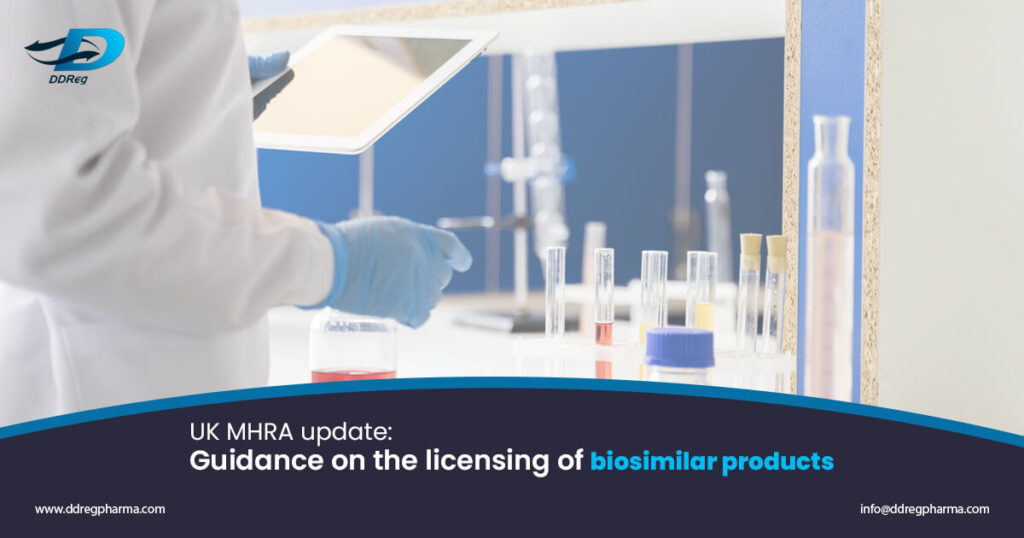The pharmaceutical regulatory landscape in the UK has experienced many changes since Brexit. Several guidelines have been updated for more UK-specific pharmaceutical product regulation. Among these includes the ‘Guidance on the licensing of biosimilar products’ that was first published on the 6th of May 2021 with the aim to outline clear requirements for biosimilar product developing in the UK/Great Britain/Northern Ireland.
Applicants should refer to the various guidelines established by the Committee for Medicinal Products for Human Use (CHMP). The UK MHRA guidelines on biosimilar licensing include revisions to CHMP guidelines and further clarifications. Details on the legislative requirements are mentioned in the guidance document.
A Great Britain (GB) reference product (RP) must be used when conducting physicochemical and biological comparability studies. This may also include an EU RP provided there is evidence that the RP is licensed via the centralized, decentralized, or mutual recognition procedures. For non-GB RPs, there must be evidence of that RP being a representative of the GB RP either through suitable information or analytical bridging data.
The principles of biosimilarity are stated in the guidance document. The contents of a biosimilar application for quality, non-clinical- clinical, risk management and product labeling are also highlighted in the guidance document and refer to various CHMP guidelines. The RP that is being used for the biosimilarity comparison exercise for quality must clearly be identified with multiple and various batches being sourced to accurately reflect the RP manufacturing variability. RP mechanism of action and critical quality attributes should be well-known and defined where functional assays that have been studied should be relevant to the mechanism of actions for all therapeutic indications.
A comprehensive biosimilar comparability exercise is needed. If differences in quality attributes are detected then they must be justified appropriately in terms of their safety, efficacy, and immunogenicity. The release/stability specification limits should be per the drug product’s critical quality attributes, biosimilar batch data, and any data that has emerged from the comparability studies. No animal in-vivo studies are required as they do not demonstrate comparability between the RP and biosimilar. However, study reports for toxicity studies that have been conducted per the Good Laboratory Practice (GLP) must be submitted.
The guidance states that in-vitro studies should be performed per the CHMP guidelines. The use of an excipient in a biosimilar product that is not present in the RP is not encouraged. However, if this is the case, then a discussion on the safety of the excipient must be presented, and justified as appropriate. For GB products, the MHRA states that Module 4 may be limited to studies that are GLP-compliant as many guidelines requiring in vivo studies exist and various pharmaceutical organizations develop products for other markets thereby having to meet other regulatory requirements. Therefore, Module 4 for GB may not be part of the CTD for other products being developed for other countries.
Comparative PK trials with PD markers are necessary for biosimilar development. Furthermore, it is imperative to collect safety and immunogenicity data. However, a comparative efficacy trial may not be required for certain biosimilars if the rationale is able to support the decision i.e., that comparable binding & other functional properties can confirm comparable efficacy. This is the case for certain molecules and so applicants should seek scientific advice regarding any additional studies.
Certain products may instigate immunogenetic reactions to specific products which is why the batch numbers must be recorded electronically in patient files for the sake of traceability.
Further details on the clinical, product labeling, RMPs, traceability, substitution, and interchangeability are outlined in detailed in the guidance document.
On 7th November, the MHRA updated the ‘Interchangeability’ section to further clarify the definition of interchangeability in terms of clinical practice where “a biosimilar product is considered to be interchangeable with another biosimilar to the same RP”. This is also keeping in line with the announcement by EMA that biosimilars can be interchanged. This facilitates switching one product to another, whether it is an RP or biosimilar, for patients.
References and Further Reading:
- UK MHRA. Guidance on the licensing of biosimilar products. 2022

